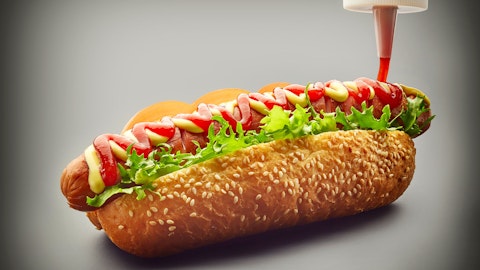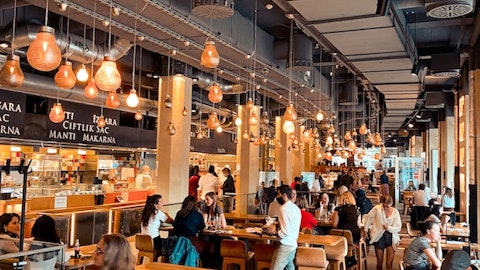Good Times Restaurants Inc. (NASDAQ:GTIM) Q4 2023 Earnings Call Transcript December 14, 2023
Operator: Good afternoon, ladies and gentlemen. Welcome to the Good Times Restaurants Incorporated Fiscal 2023 Fourth Quarter and Year-End Earnings Call. By now, everyone should have access to the company’s earnings release, which is available in the Investors section of the company’s website. As a reminder, a part of today’s discussion will include forward-looking statements within the meaning of Federal Securities Laws. These forward-looking statements are not guarantees of future performance, and therefore, you should not put undue reliance on them. These statements involve known and unknown risks, which may cause the company’s actual results to differ materially from results expressed or implied by the forward-looking statements.
Such risks and uncertainties include among other things, the market price of the company’s stock prevailing from time-to-time, the nature of other investment opportunities presented to the company, the disruption to our business from pandemics and other public health emergencies, the impact and duration of staff constraints at our restaurants, the impact of supply chain constraints and inflation, the uncertain nature of current restraints, development plans, and the ability to implement those plans and integrate new restaurants, delays in developing and opening new restaurants because of weather, local permitting, or other reasons, increased competition, cost increase or shortages in raw food material, other general economic and operating conditions, risks associated with our share repurchase program, risks associated with the acquisition of additional restaurants, the accuracy of cash flows, and the cost and availability of capital or credit facility borrowings to provide liquidity, changes in federal, state, or local laws and regulations affecting the operation of our restaurants, including minimum wage and tip credit regulations and other matters discussed under the risk factors section of Good Times annual report on Form 10-K for the fiscal year ended September 26, 2023, filed with the SEC and other filings with the SEC.
During today’s call, the company will discuss non-GAAP measures, which they believe can be useful in evaluating our performance. The presentation of this additional information should not be considered in isolation or as a substitute for results prepared in accordance with GAAP and reconciliation to comparable GAAP measures available in our earnings release. And now I would like to turn the call over to Ryan. Please go ahead, sir.
Ryan Zink: Thank you, Krista, and thank you all for joining us on the call today. As mentioned, everyone should now have access to our fourth quarter earnings release and our 10-K filing. As with last quarter, the final quarter of the fiscal year delivered mixed results with continued strong performance at our Good Times brand, where we again posted another quarter of positive same-store sales. In addition to the positive sales, we were able to improve margins compared with prior year, primarily through the benefit of lower food and packaging costs. Near the end of the fiscal year, as had previously been reported, we purchased two Good Times restaurants from prior franchisees. And though there were the typical transition and integration inefficiencies that initially accompanied the acquisition of these restaurants.
We are currently growing year-over-year sales at both restaurants, and both restaurants are profitable and contributing to the brand’s overall results. We now own and operate 25 company-owned Good Times restaurants, including six restaurants in which we are equal partners with a third-party. Additionally, we have six restaurants in the system that are franchisee-owned. We launched our loyalty program, GT Rewards, during the quarter. GT Rewards is a points-based loyalty offering that provides our guests an opportunity to earn deals and other rewards driven by the purchasing behavior. The app already provided order ahead and direct order of delivery. And the GT Rewards platform is accessible by our guests, both in a digital native order and also in a traditional drive-through transaction with the order being placed at the Menu Ordering Board.
While card-based payment for digital native orders has been a part of the app from its initial release, payment in the drive-through has not been a feature of our app. We intend for the next major release of the app to incorporate the ability to link a credit or debit card, or a Good Times gift card by which payment can be made in the drive-through. In addition to our company-owned restaurants participating in the GT Rewards program, all of our franchisee-owned restaurants in Colorado also are currently participating in the program. We believe that the convenience, value, and technology enablement that our app now delivers to our guests is critical to the continued relevance of our brand, and our ability to capture incremental share in the QSR Burger space.
Further, during the first quarter of fiscal 2024, we completed the full digital menu transition of the company-owned restaurants with the installation of digital menu boards at the walk-up windows complementing the menu boards that were already installed in the drive-throughs during fiscal 2023. Additionally, the installation of the digital drive-through menu board at the Lafayette restaurant that we recently purchased was completed just earlier today. Our franchise system in Colorado has yet to deploy the digital walk-up menu boards, and we still have one Colorado franchisee-owned restaurant that does not yet have the drive-through menu boards. We have also completed the re-image of two Good Times restaurants and are nearing the completion of a third restaurant.
This re-image package includes repainting the building in light and dark shades of gray as opposed to a more beige tone previously, the replacement of highly graphic awnings with solid red awnings, and the contribution of community art to our buildings through the painting of a unique wall mural by a selection of local artists. These re-image elements combine to create a clean, crisp design for our buildings that align with guest feedback and the results of consumer research we have conducted surrounding the purchasing behavior of our guests. Same-store sales have remained positive to-date through the first fiscal quarter, though late November and December, have experienced significant unfavorable weather with colder average temperatures than the prior year, but the greater impact has been two large Denver area snowfall events occurring on weekends, including Black Friday and the entire weekend following Thanksgiving holiday.
This weather activity has muted the strong trend we had been experiencing early in the quarter. At Bad Daddy’s, operating results deteriorated from the prior quarter. Reduced sales have impacted most other areas of the P&L with significant deleveraging effects in labor costs and other operating expenses. Sales have further continued to be soft into the first quarter of the new year, and as a result, changes within the Bad Daddy’s organization have been made. Our prior operations leader for Bad Daddy’s left the company in late August. And for the moment, the four regional directors that previously reported to him are reporting directly to me. We have long excelled in our back of house execution, and we continue to excel in that area. We serve remarkable food and our employees throughout the brand, including both management and hourly team members, have so much passion around serving up great burgers.
However, that same passion had declined in our front of house and the level of hospitality we have been providing was not meeting our customers’ wants or needs. We also failed to pivot back to the bar side of our business as pandemic behavior faded and our bar execution has lacked. The ultimate solution to this is a mindset shift among our operations leadership team within the brand. However, to accomplish that, tactical changes are needed to drive the alignment desired. We’ve appointed a bar and beverage leader to complement the culinary processes we already have in place. Happy hour specials have been launched in our Colorado restaurants and we expect those specials to be system-wide by mid-January. This is the first time in the concept’s history when drink specials will be available in all restaurants.
Further, to additionally support the bar business, we extended operating hours by an average of one hour per day to begin closing at 10:00 p.m. Sunday through Thursday, and 11:00 p.m. Friday and Saturday beginning on November 27. The extended operating hours have already begun to pay dividends as sales during the last two operating hours of each day have measurably increased. And the same-store sales trend, which had further deteriorated in October and November, has improved sequentially with significant gains in the dinner and late night day parts. We’ve overhauled the beverage portfolio with new core beer and spirits offerings that better align with our guest preferences, and a new cocktail menu with more concept appropriate cocktails that will launch in February.

Additionally, on a seasonal basis, we’ve incorporated new cocktails, shakes, and mocktails into our seasonal chef special program. New improved training content and teaching methods have accompanied and will accompany all of these programs. To address the inconsistent hospitality, we’re taking a three-pronged approach. First, by replacing our training manager for Bad Daddy’s, who was previously a one-person team, and then supplementing that new individual with two other learning and development specialists, who will assist our operators in the delivery of training content and the validation of the hard and soft skills that are critical in each role. Resetting expectations and standards of our multi-unit leaders and re-systematizing their roles with appropriate tools, systems, and accountability that had become lacking and was resulting in lower than desired standards in the front of the house.
And finally, adjusting financial system incentives, AKA bonus, for our restaurant management teams to better incentivize a combination of long-term profitability and sales growth, along with period-by-period guest satisfaction, financial controls, and operations excellence. Our prior bonus structure was also designed to address each of these. However, the revisions to the plan better balance all of these and reduce incentives to prioritize behaviors that improve single period results, but could have negative full-year or longer term impacts. Our Atlanta market discussed on prior calls has continued to prove to be a challenge. We’ve invested heavily in management development, new management where necessary, and additional hourly labor to improve our reputation in the market.
These investments are starting to show early indications of delivering results as the incessant and unrelenting declines in sales at each of these stores have recently given way to days and in some cases weeks of increasing year-over-year sales. We continue to evaluate the optimal restaurant portfolio in the Atlanta market, which will be influenced by each restaurants performance in the first six to nine months of this fiscal year. While Bad Daddy’s results for the quarter are disappointing and our expectations for the first quarter of the year are for disappointing, and our expectations for the first quarter of the year are for similar, if not slightly lower, performance, I’m confident in the relevance and the power of the brand. As our highest volume restaurant in Somerville, South Carolina continues to post positive year-over-year sales, Our second highest volume restaurant in Charlotte, North Carolina is also delivering positive sales growth, as our several other restaurants.
Additionally, our new restaurant in Madison, Alabama is continuing to deliver top quartile average weekly sales three full months into operations. While there has been some honeymoon effect, the typical peak to trough decline experienced in new Bad Daddy’s new store openings has not manifested that same decline here. I have great confidence in the future of the Bad Daddy’s brand, as the passion this team has for the brand is unlike the passion I’ve seen anywhere in my past. The company has gone without a finance leader for nearly nine months, though for the past four months we have contracted with a highly capable finance and accounting professional in an exclusive consulting engagement, who has performed many of the responsibilities of our former Vice President of Finance.
We expect to have news with respect to a permanent hire for this leadership role in the upcoming weeks. I’ll now review this quarter’s results. Total revenues decreased approximately 2.5% for the quarter to $34.3 million and decreased approximately 0.1% to $138.1 million for the year, compared to fiscal 2022. Total restaurant sales for Bad Daddy’s restaurants decreased $1.4 million to $24.6 million for the fourth quarter, compared to the prior fourth quarter and decreased $1.0 million to $102.2 million for the year, compared to the 2022 fiscal year. The sales decline was a combination of reduced sales associated with the closure of the Cherry Creek restaurant earlier in the year, the temporary closure of approximately three weeks during the third quarter for the remodel of the formerly franchised Greenville South Carolina restaurant and the decline in same-store sales of 4.9% during the quarter, with 39 Bad Daddy’s restaurants in the comp base at the end of the quarter.
Menu prices during the quarter were approximately 4.4% higher than the prior year. We expect same-store sales to be mid-single-digit negative for the first quarter of fiscal 2024. Cost of sales at Bad Daddy’s were 31.8% for the quarter, a 100 basis point decrease from last year’s quarter with benefits from costs versus 2022 across our basket. Though there’s somewhat — some upward pressure on beef, we believe there is otherwise some general stability in our commodity basket and expect similar results in Q1. Experts continue to predict that beef prices will likely rise over the next 12 to 18 months from their current level, which is already slightly elevated from a long-term historical perspective. Bad Daddy’s labor costs increased by 310 basis points, compared to the prior year quarter to 36.3% for the quarter.
This increase as a percentage of sales reflects higher wage rates, higher levels of staffing, compared to 2022, the deleveraging impact of lower sales on management costs, and additionally reflects post-opening labor inefficiencies and extended training team presence in our new restaurant in Madison, Alabama. Occupancy costs at Bad Daddy’s decreased 20 basis points to 6.2%. Other operating costs at Bad Daddy’s increased by 50 basis points, compared to the prior year quarter to 15.2% for the quarter, primarily the result of the deleveraging impact of lower sales on certain fixed costs. Overall restaurant-level operating profit, a non-GAAP measure for Bad Daddy’s, was approximately $2.6 million for the quarter, or 10.6% as a percent of sales, compared to $3.4 million or 12.9% last year.
Total restaurant sales for company-owned good times restaurants increased by approximately $0.6 million to $9.5 million for the fourth quarter, compared to the same prior year fourth quarter and increased $1.0 million to $35.0 million for the year, compared to the 2022 fiscal year. The average menu price increase for the quarter was approximately 6.8% over the same prior year quarter. Same store sales increased 2.4% for the quarter. Sales growth accelerated early into the new quarter, but as mentioned earlier has softened on unfavorable weather comparisons. Food and packaging costs for Good Times were 30.5% for the quarter, a decrease of 180 basis points, compared to last year’s quarter. As was the case with Bad Daddy’s, the longer-term forecast indicates resumed pressure on beef prices from current levels.
Total labor costs for Good Times increased to 33.1%, a 120 basis point increase from the 31.9% we ran during last year’s quarter, due primarily to higher wage rates driven by overall labor market pressure in Colorado and the 8% increase in the statutory minimum wage in Denver. Occupancy costs at good times were 8.2%, an increase of 40 basis points from the prior year quarter, primarily driven by higher real estate taxes. Good Times other operating costs were 12.0% for the quarter, a decrease of 70 basis points. Restaurant level operating profit for Good Times increased by $0.1 million for the quarter to $1.5 million. As a percent of sales, restaurant level operating profit increased by 90 basis points versus last year to 16.2%, due primarily to higher sales and the improvement in food and packaging costs.
Combined general and administrative expenses were $2.0 million during the quarter or 6.1% as a percent of total revenues. The decline in G&A costs is primarily attributable to the reduction in legal and professional fees incurred in the prior year associated with litigation defense. We continue to expect for general and administrative costs to run at approximately 7% to 7.5% of sales on a full-year basis, with some of the additional support personnel detailed earlier in this call. We recorded impairment charges of approximately $0.5 million, primarily related to the Greenville, North Carolina restaurant, which has long been marginally profitable, but has seen some trade area deterioration over the past six months. Our net loss to common shareholders for the quarter was $0.3 million, or a loss of $0.02 per share versus net loss of $1.3 million, or $0.10 per share in the fourth quarter last year.
Approximately $0.3 million of income tax benefit was recognized during the quarter. Adjusted EBITDA for the quarter was $1.1 million, compared to $0.9 million for the fourth quarter of 2022. We finished the quarter with $4.2 million in cash and approximately $0.8 million of long-term debt. With that, Krista, we will open the call for questions.
See also 11 Most Profitable Bank Stocks To Invest In and 13 Most Profitable Pharmaceutical Stocks Now.
Q&A Session
Follow Good Times Restaurants Inc. (NASDAQ:GTIM)
Follow Good Times Restaurants Inc. (NASDAQ:GTIM)
Operator: [Operator Instructions] We have a question. Your first question comes from Brian London, an Individual Investor. Please go ahead.
Brian London: Hi, Ryan. Just a quick question. On the Good Times brand, you guys invested money and it seems like you’re reaping some of the benefits of improving the stores. Do you think there’s any opportunity for growing the Good Times restaurant or looking, you know, forward over the next two or three years?
Ryan Zink: I think the challenges associated with that in the immediate future are we have a large presence here in the Colorado market and real estate prices combined with wages decrease the attractiveness of doing so, and I think it’s a bit of a big bet to jump to another market. With that, I would say we continue to believe in the Good Times brand and I would say that if we continue to see strong sales that accompany the investments that we’ve made and the continued investments that we will make in some of the light refreshes, the remodels that I described earlier in the call, the possibility exists for future development of that brand.
Brian London: Okay, thanks. The Bad Daddy results, I mean, I’m — you know, I know this is anecdotal, but following a lot of restaurants, feeling like there’s recessionary pressures, kind of, on that type of restaurant. I don’t know if you have any feel for that or feedback, but that kind of led me a little bit into the Good Times question. I’m wondering if there are pressures, like recessionary-type pressures on the Bad Daddy’s brand over the next few years, I was wondering like if you might look towards, you know, Good Times expansion, but yes, I know I totally understand your comments in regard to real estate prices and appreciate your answer.
Ryan Zink: Yes, and I’ll offer some color on that. I mean, you know, we have to be cognizant of the reality in the environment that we operate in. And, you know, I don’t want to make excuses for our team and I don’t want our team to make excuses for the restaurant’s performance. I do believe that if you look at other burger-centric casual dining brands, there are pressures there. And so I think our performance, while disappointing, is not entirely surprising, compared — considering some of the results that have been reported by similar concepts. That said, I think our Bad Daddy’s concept has a greater degree of relevance. And I think if we execute the operations, strategies, and tactics that I’ve outlined on this call, that we’re going to be in a good position to compete against our casual dining peers now and in the future.
That said, I think it’s beneficial to have a portfolio that includes concepts both in the full service and in the QSR segment, because I think the QSR segment does tend to perform better when there are recessionary pressures.
Brian London: Thank you. Yes, I appreciate the answer. Also, again, I appreciate, I think that your strong balance sheet will help you out, and happy holidays to you guys. Thanks.
Ryan Zink: Happy holidays to you as well.
Operator: Your next question comes from the line of [Sanjay Raigaga] (ph), who is also a Private Investor. Please go ahead.
Unidentified Analyst: Hi Ryan. I just wanted to ask on the Bad Daddy’s of brand. So first of all, if you could just give a brief update on the Seaboard Station location, what’s going on there? And just in general, do you guys have like an expectation of when you, you know, when the Bad Daddy’s, same-store sales will start, you know, kind of, either being neutral or positive. Is this like the first quarter, second quarter? Do you guys have some sort of idea there?
Ryan Zink: Yes, so to answer your first question on Seaboard Station, I was there about six to eight weeks ago and the — to be quite frank, the traffic and construction situation there is pretty painful. There are our main entrance has been blocked off, access to the site is extremely compromised. We believe there is a lot of multi-unit residential being constructed there. And the long-term outlook for that site is extremely strong once the construction is finished. However, it seems like it has been and continues to be a bit of a never-ending point of pain in terms of the construction that is occurring and the impact of that. I don’t believe that we’ve received from our landlord or other developers, who are participating in that construction a real clear timeline on when that’s going to end.
And I would like that as much as you and our other investors would like that. With respect to same store sales turnaround, that’s an interesting question and one that I would love to be able to provide you a precise answer on. What I would say is that our comparable start to get easier in the third fiscal quarter, so the June quarter. I’m nor predicting that it will be turned around by then to the point whoever posting positive same-store sales. But internally we have the goals of we’ve set and I’m setting aggressive goals with my team and certainly, you know, I would love to be in a position where come June quarter that’s what I’m reporting.




